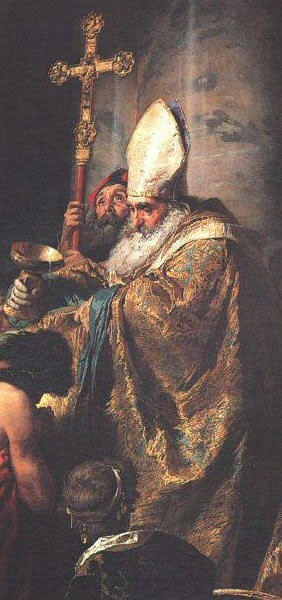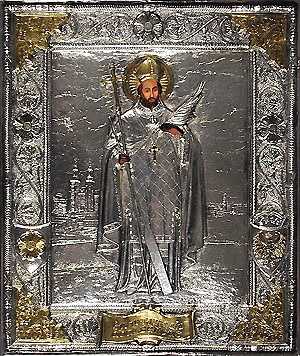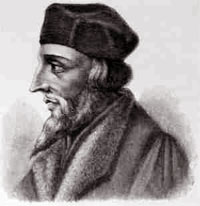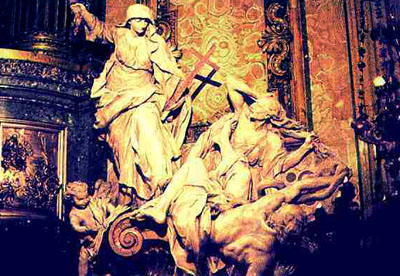 |
The Saint of the Day
St. Adalbert of Prague, April 23
Prof. Plinio Corrêa de Oliveira
Biographical selection:

St. Adalbert baptized pagans of Hungary, Poland and Prussia, but the inhabitants of Prague rejected him
|
Adalbert was born in 956 into an illustrious family of Bohemia. In childhood he was taken by a fatal illness and his parents made a vow to the Holy Virgin to offer him to the priesthood if he would be cured. Their prayers were answered, and the boy recovered his health. They sent their son to Magdeburg to the saintly Archbishop of Magdeburg, who oversaw his education in religion and science.
In 973 he received holy orders from the Bishop of Prague. Later, this Bishop died a bad death, screaming in despair on his deathbed that he would be condemned for his negligence to his duties and ardent pursuit of honors, wealth and pleasures. A witness to this sad end, Adalbert never forgot it, taking it as a lesson for the rest of his life. The next year he was chosen as Bishop of Prague.
He entered Prague barefoot and was joyfully received by the people. The Diocese was in a deplorable situation. Some of its inhabitants were still idolaters, and many Catholics were well entrenched in shameful vices. In vain St. Adalbert tried to correct them and to bring them to religion and piety. When his efforts proved fruitless, he obtained papal permission to leave the Episcopate and enter a monastery in Rome. After five years, Pope John XV sent him back to Prague with the provision that he could again leave the Episcopate if the people did not correspond.
A second time he was received joyfully, and the people promised to correct themselves and leave their heathen practices. These hasty promises were soon forgotten, however, and the Saint determined to abandon them forever and return to his monastery. On his way back to Rome, he met with a great success in Hungary, where he converted many to Catholicism. With this, the Pope ordered him to not come to Rome, but to return to Prague. At this news, the elites of Prague became enraged and killed many relatives of the Saint, stole his belongings, and burned the family castles.
Adalbert went to Boleslaus, his friend, son of the Duke of Poland. In this country he again converted many idolaters. On a missionary trip to Prussia he converted some of the inhabitants of Danzig. It was there that he met his death when a group of pagans attacked him. When he received the first blow, he thanked God for giving him the opportunity to suffer for Him. Then the pagan priest leading the idolaters pierced his body with a two-headed lance, saying: “Be joyous, then, since you want nothing more than to suffer with your Christ.” It was April 23, 997.
Comments of Prof. Plinio:
This life is so dense in teachings that we could analyze it point by point. Let us take only some of them.

An icon of St. Adalbert. He is a patron saint of Poland, Bohemia & Prussia
|
First, we can consider the situation in the Middle Ages. It is erroneous to imagine that in that time the Church was crowned with glory sleeping in a bed of flowers for 1000 years. The fact is that during those 1000 years the life of the Church was a hard fight. The reality is that the Church won that fight because many generous souls, called by God to make the sacrifice of their lives, said “yes.” In other times the Church has had to face the same fight, but instead of saying “yes,” persons called by God say “no,” or “perhaps” – which is the more detestable way to say “no.” So, the Church is badly served and as a consequence, civilization slides downhill. This applies to the facts we just heard regarding the Middle Ages.
Second, Prague was an important city of that time. It was situated in an area newly evangelized by the Church, still lacking a Catholic civilization. Great attention was being paid to it, just as today people pay special attention to new areas that are just starting to develop and be civilized. In Prague there was a Bishop who had the responsibility to further the Reign of Our Lord and Our Lady in that region. His mission was to confirm the Catholics in their faith and to convert those who were not Catholics. But he was bad and died in despair.
Third, even in this death we can see some medieval characteristics that almost no longer exist. Today almost no one dies in dramas of despair. Sinners like this Bishop and even worse die listening to music and such, completely indifferent to their responsibilities. They do so cynically, calmly, saying good bye to everyone and pretending they have nothing to fear. There is no longer shame felt for the sins committed and the evil done. It is a complete indifference, and a general insensibility. The worst thing is that this moral insensibility reflects the person’s loss of the sense of good and evil, the sense of what comes from God and what comes from the Devil.

The heretic Jan Hus
|
Such insensibility was much rarer in the Middle Ages. Certainly the Church had to fight against all kinds of enemies, as we heard in this selection. But it rarely happened that a man would have the kind of indifferent death we see today. Persons could die blaspheming, or in despair; others would convert in extremis [at the last moment]. But almost no one died in the cynicism and indifference so common today.
Fourth, so we see that the Bishop of Prague died with signs of horror, with signs of his condemnation. One good result was the healthy shock this caused in the life of a future saint. Remembering this sight, St. Adalbert decided to humbly enter Prague barefoot when he was chosen to be the successor of that man. Doing this, he was showing that he was a penitent Bishop, and not a dissolute Bishop. It was his way of saying that he would not follow in the steps of his predecessor, that he would lead the Diocese in a way completely different from his predecessor. It was a strong statement that showed his disapproval not only of the bad Bishop, but also of the bad faction of Catholics of that city.
Fifth, a curious fact that contradicts later events is that twice the people received him very well. Nonetheless, they were incorrigible. They resisted the efforts of the Saint during his whole lifetime. They became, in effect, his great cross. He preached to these people, and they didn’t convert. Afterwards, he preached to the Hungarians and the Prussians and they converted, but his own people did not. They remained bad to the end.
Nothing is automatic in the life of the Church. Some persons think that if a city or an area has a saint, it will automatically convert. It doesn’t work this way. While it is true that often a saint is enough to convert a region, at other times bad people can resist the action of the greatest saints, just as the Jews resisted the action of Our Lord Jesus Christ, who was the Man-God Himself.
Sixth, the result of this rejection of St. Adalbert by Bohemia – it is interesting to see the consequences of the rejection of a saint – is that it continued to be a bad region for a long time. With John Hus, Bohemia took an early lead in the Protestant revolution, and after it, Bohemia was one of the strongholds of Protestantism.

In the Church of Gesu in Rome, a representation of Holy Mother Church driving out the heretics Luther and Hus
|
Although Bohemia was subject to the House of Austria, it always constituted a problem. Later it became a socialist republic. Furthermore, this people did not rise up with any particular reaction against Communism when it took over Czechoslovakia. That is to say, that rejection of old, that bad character from its past, generated a bad people until our days. There were, of course, exceptions. There were many good people there, many saints. But a bad current always continued.
We should imitate St. Adalbert in bringing the truth and the traditional Catholic position to our countries. If we do so in the right way, fearlessly and humbly, as St. Adalbert did, we invite our countries to adhere to the right path.
We should pray to St. Adalbert and especially to Our Lady to help convert our countries and our American continent. We should ask that we are generous enough to answer “yes,” and never “perhaps” to the invitation God makes to us to help Him.


  | | Prof. Plinio Corrêa de Oliveira | |
The Saint of the Day features highlights from the lives of saints based on comments made by the late Prof. Plinio Corrêa de Oliveira. Following the example of St. John Bosco who used to make similar talks for the boys of his College, each evening it was Prof. Plinio’s custom to make a short commentary on the lives of the next day’s saint in a meeting for youth in order to encourage them in the practice of virtue and love for the Catholic Church. TIA thought that its readers could profit from these valuable commentaries.
The texts of both the biographical data and the comments come from personal notes taken by Atila S. Guimarães from 1964 to 1995. Given the fact that the source is a personal notebook, it is possible that at times the biographic notes transcribed here will not rigorously follow the original text read by Prof. Plinio. The commentaries have also been adapted and translated for TIA’s site.
|
Saint of the Day | Home | Books | CDs | Search | Contact Us | Donate

© 2002- Tradition in Action, Inc. All Rights Reserved
|
 |

|